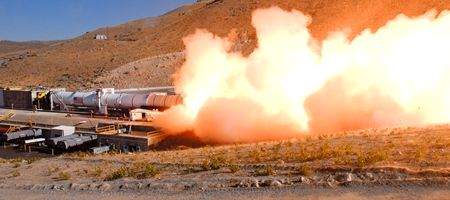NASA has successfully completed a two-minute, full-scale test of its DM-2 rocket motor – despite not knowing for sure whether it will ever actually be going anywhere.

The original plan was for the motor to form the first stage of the Ares I rocket, which was to ferry atronauts to the International Space Station. It would also have formed part of the Ares V rocket for moon missions.
But with the Obama administration planning to cancel the Constellation moon landing program, and other bills passing through Congress scaling back spaceflight generally, there’s no knowing when or even whether the rocket will ever see action. NASA says it’s potentially transferable to future heavy-lift launch vehicle designs, which aren’t under threat.
NASA says the DM-2 is its most heavily instrumented solid rocket motor ever, with a total of 53 test objectives measured through more than 760 instruments.
The stationary firing was conducted by ATK. First, the solid rocket motor was cooled to 40 degrees Fahrenheit to verify the performance of new materials and assess motor performance at low temperatures during the full-duration test. Initial test data showed that performance met all expectations.
“For every few degrees the temperature rises, solid propellant burns slightly faster and only through robust ground testing can we understand how material and motor performance is impacted by different operating conditions,” said Alex Priskos, first stage manager for Ares Projects at NASA’s Marshall Space Flight Center.
“Ground-testing at temperature extremes pushes this system to its limits, which advances our understanding of five-segment solid rocket motor performance.”
The first-stage solid rocket motor is designed to generate up to 3.6 million pounds of thrust at launch. Information collected from this test, together with data from the first development motor test last year, will be examined to improve understanding of the design’s performance and reliability.
The five-segment development motor is similar to the solid rocket boosters that help power the space shuttle to orbit, but includes several upgrades and technology improvements. These include the addition of a fifth segment, a larger nozzle throat, and upgraded insulation and liner.






